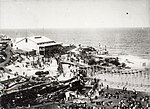Bronte Beach

Bronte Beach is a small but popular recreational beach in the Eastern Suburbs of Sydney, Australia. It is a division of the LGA of Waverley Council. Bronte Beach is 2 kilometres south of Bondi Beach and north of the much larger Coogee Beach. A long distance ocean swimming event is held every December between Bondi Beach and Bronte. The three beaches are linked by a paved coastal footpath along the rocky cliff tops, much frequented by tourists and local runners and walkers. The beach is popular with surfers and despite the non rough surf, less abled swimmers can avail themselves of the bogey hole or rock pool towards the southern end of the beach. At the south end of the beach is a 30-metre ocean pool, one of the best known in Sydney. Also directly opposite from Bronte there are some popular cafes.
Excerpt from the Wikipedia article Bronte Beach (License: CC BY-SA 3.0, Authors, Images).Bronte Beach
Beach Promenade, Sydney Bronte
Geographical coordinates (GPS) Address Nearby Places Show on map
Geographical coordinates (GPS)
| Latitude | Longitude |
|---|---|
| N -33.9036 ° | E 151.2683 ° |
Address
Beach Promenade
Beach Promenade
2024 Sydney, Bronte
New South Wales, Australia
Open on Google Maps









